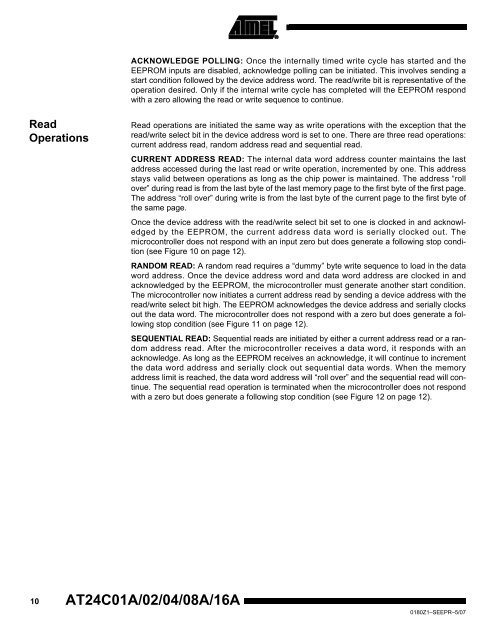Two-wire Serial EEPROM AT24C01A(1 ... - Atmel Corporation
Two-wire Serial EEPROM AT24C01A(1 ... - Atmel Corporation
Two-wire Serial EEPROM AT24C01A(1 ... - Atmel Corporation
You also want an ePaper? Increase the reach of your titles
YUMPU automatically turns print PDFs into web optimized ePapers that Google loves.
Read<br />
Operations<br />
ACKNOWLEDGE POLLING: Once the internally timed write cycle has started and the<br />
<strong>EEPROM</strong> inputs are disabled, acknowledge polling can be initiated. This involves sending a<br />
start condition followed by the device address word. The read/write bit is representative of the<br />
operation desired. Only if the internal write cycle has completed will the <strong>EEPROM</strong> respond<br />
with a zero allowing the read or write sequence to continue.<br />
Read operations are initiated the same way as write operations with the exception that the<br />
read/write select bit in the device address word is set to one. There are three read operations:<br />
current address read, random address read and sequential read.<br />
CURRENT ADDRESS READ: The internal data word address counter maintains the last<br />
address accessed during the last read or write operation, incremented by one. This address<br />
stays valid between operations as long as the chip power is maintained. The address “roll<br />
over” during read is from the last byte of the last memory page to the first byte of the first page.<br />
The address “roll over” during write is from the last byte of the current page to the first byte of<br />
the same page.<br />
Once the device address with the read/write select bit set to one is clocked in and acknowledged<br />
by the <strong>EEPROM</strong>, the current address data word is serially clocked out. The<br />
microcontroller does not respond with an input zero but does generate a following stop condition<br />
(see Figure 10 on page 12).<br />
RANDOM READ: A random read requires a “dummy” byte write sequence to load in the data<br />
word address. Once the device address word and data word address are clocked in and<br />
acknowledged by the <strong>EEPROM</strong>, the microcontroller must generate another start condition.<br />
The microcontroller now initiates a current address read by sending a device address with the<br />
read/write select bit high. The <strong>EEPROM</strong> acknowledges the device address and serially clocks<br />
out the data word. The microcontroller does not respond with a zero but does generate a following<br />
stop condition (see Figure 11 on page 12).<br />
SEQUENTIAL READ: Sequential reads are initiated by either a current address read or a random<br />
address read. After the microcontroller receives a data word, it responds with an<br />
acknowledge. As long as the <strong>EEPROM</strong> receives an acknowledge, it will continue to increment<br />
the data word address and serially clock out sequential data words. When the memory<br />
address limit is reached, the data word address will “roll over” and the sequential read will continue.<br />
The sequential read operation is terminated when the microcontroller does not respond<br />
with a zero but does generate a following stop condition (see Figure 12 on page 12).<br />
10 <strong>AT24C01A</strong>/02/04/08A/16A<br />
0180Z1–SEEPR–5/07

















